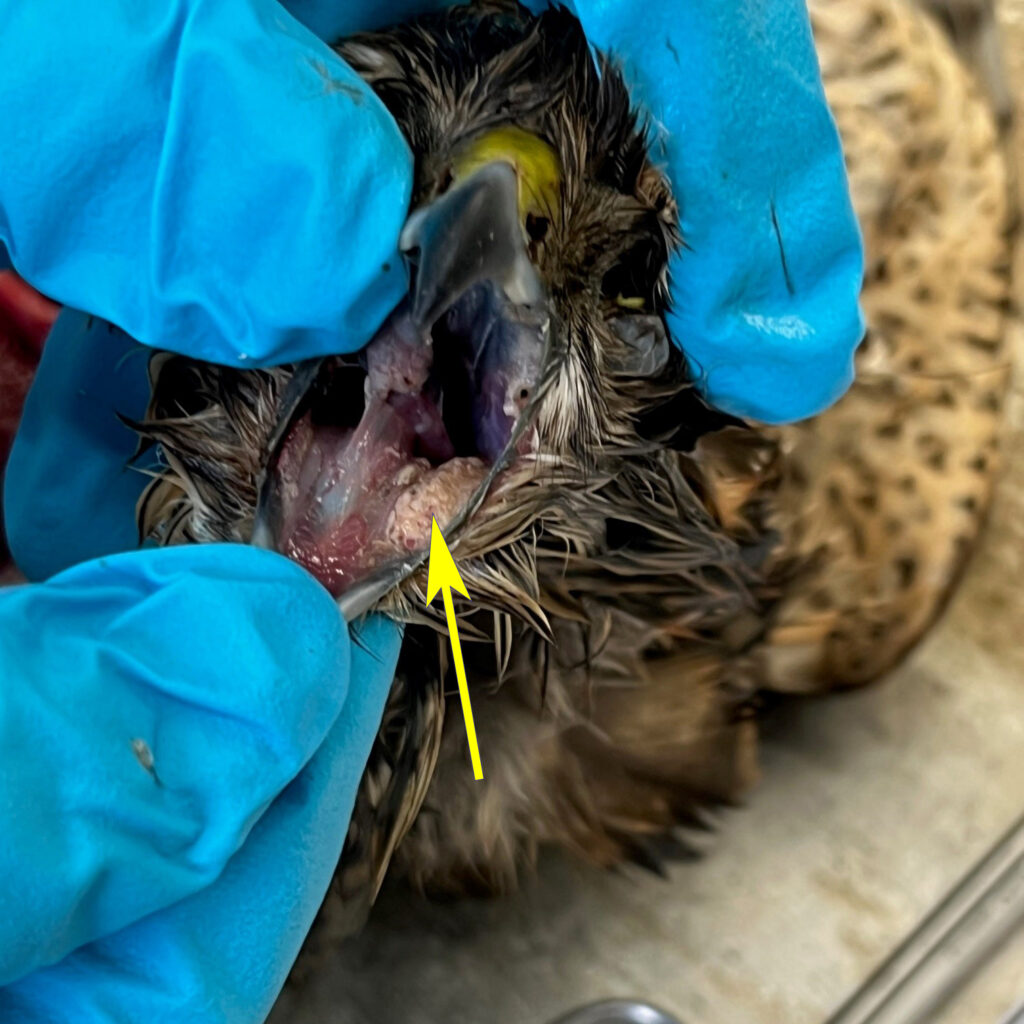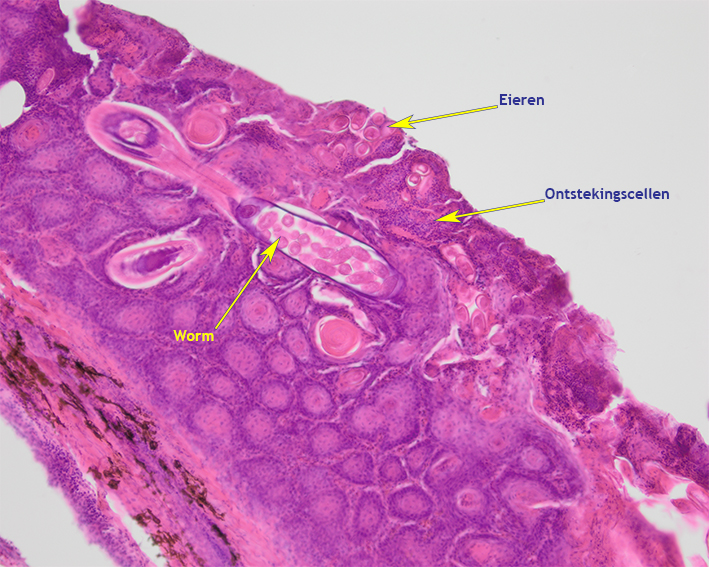Eucoleus dispar found in Eurasian sparrowhawks
In both January and February 2023, a Eurasian sparrowhawk (Accipiter nisus) was examined by the DWHC. Both sparrowhawks had inflammations of the oral mucosa, and one also had an inflammation of the crop. In both birds these inflammations were caused by the nematode (roundworm) Eucoleus dispar.
The parasite E. dispar
E. dispar is a roundworm that lives in the upper digestive system, namely the beak (including tongue and oral mucosa), crop, throat and oesophagus (1). The parasite has a ‘direct’ lifecycle, meaning there is no need for an intermediate host for the development of the parasite. But earthworms can act as a ‘paratenic host’ (1). A paratenic host is a host that is not necessary for the development of the worm, but can act as an “accidental” intermediate host.
The examination results
One sparrowhawk was an adult female specimen. She was ringed in Valsörarna, Korsholm in Finland as a first year bird on 25th september in 2022. This female bird was found dead in a garden in the municipality of Pekela in the province of Groningen. The other sparrowhawk was an adult male specimen and was found in the municipality of Aa en Hunze in the province of Drenthe.
Both sparrowhawks were in bad body condition, and had died of gastro-intestinal bleeding. This type of bleeding can occur in birds when these have not eaten for one to several days, depending on the size of the animal.

Both birds had a yellowish-braun to white-yellow deposit of soft layered, dull material on the mucosa of the oral cavity (see picture 1). A similar yellowish material can occur in cases of ‘canker’ caused by Trichomonas, or in cases of the birdpox virus. Because ‘canker’ has been found in dead pigeons in the last months, a higher mortality among pigeon-eating raptors can be expected. However, in the examined sparrowhawks ‘canker’ and the birdpox virus were excluded by histological examination, and the plaques were revealed to be caused by E. dispar. Microscopically, parts of the worm, eggs and inflammatory reactions were seen (see picture 2). Most likely the birds were not able to eat sufficiently due to the oral inflammations, causing haemorrhages in the gastro-intestinal tract that were lethal.

Consequences of an infection with E. dispar
The two sparrowhawks that were examined in 2023, were skinny and had chronic inflammation in the oral cavity. As such, the infection with E. dispar in these birds did likely contribute to the cause of death. However, it is not always possible to assess whether the found infection had an adverse effect on the condition of the animal (2).
An infection with a parasite does not necessarily cause an inflammation. For example, there was a case of a red kite (Milvus milvus) where eggs of E. dispar were found in the tongue, but without an inflammatory reaction (3). It is possible that the parasite was not long enough present to cause an inflammatory reaction. It could also be possible that an infection does not always lead to an inflammation.
Furthermore, in North-America cases have been reported of living, Sharp-shinned hawks (Accipiter striatus) in good body condition, but having yellow plaques in the beak (4). These plaques were found to be caused by E. dispar. The animals showed no clinical symptoms, and did not (yet) have problems with eating.
The two Eurasian sparrowhawks that were examined this year by the DWHC, were in very poor body condition so they obviously were not able to eat sufficiently. This was also found in England/Wales in 2021 in a buzzard (Buteo buteo) that was cachectic. The APHA Disease of Wildlife Scheme indicates that E. dispar is widespread in raptors, but rarely the cause of death (5).
Prevalence of E. dispar in raptors
E. dispar has been found in several raptor species, but research in South-Italy found it most often in buzzards (6) (see also Table 1). Within the raptors examined by the DWHC between 2010 and 2020, E. dispar was also mostly found in buzzards (see also Table 1). In 2021 and 2022 the DWHC did not examine any raptor birds for E. dispar, as these birds were reserved for testing for Avian Influenza. In older Dutch research, the parasite was found only in two buzzards (7) (see also Table 1).
Table 1: Results of E. dispar examination in raptors
| Raptor species | DWHC (2010 – 2020*) | Santoro (6) (2000 – 2008) | Borgsteede (7) (1975 – 1995) |
| Western Marsh Harrier (Circus aeruginosus) | 1/1 (100%) | 4/12 (33%) | 0/10 (0%) |
| Buzzard (Buteo buteo) | 20/54 (37 %) | 15/35 (43%) | 2/56 (4%) |
| Montagu’s Harrier (Circus pygargus) | 0/3 (0%) | – | – |
| Northern Goshawk (Accipiter gentilis) | 4/16 (25%) | – | 0/15 (0%) |
| Peregrine falcon (Falco peregrinus) | 1/7 (14%) | 4/12 (33%) | 0/2 (0%) |
| Eurasian Sparrowhawk (Accipiter nisus) | 1/26 ( 4 %) | 1/16 (6%) | 0/9 (0%) |
| Common Kestrel (Falco tinnunculus) | 0/9 (0%) | 1/25 (4%) | 0/31 (0%) |
| European honey buzzard (Pernis apivorus) | – | 1/16 (6%) | 0/5 (0%) |
Furthermore, in the period 2010-2020, the DWHC examined a White-tailed Eagle (Haliaeetus albicilla) and a Black Kite (Milvus migrans). In these birds, the roundworm E. dispar was not found. Borgsteede (7) also did not find this parasite in the following raptor birds: one Lesser spotted Eagle (Aquila pomarina), four Rough-legged Buzzards (Buteo lagopus), two Short-toed Snake Eagles (Circaetus gallicus), three Hen Harriers (Circus cyaneus), two Merlins (Falco columbarius) and six Eurasian Hobbies (Falco subbuteo).
Literature
- Krone, O. & Cooper, J.E., 2002. Parasitic disease. In: Cooper, J.E. (Ed.), Birds of Prey. Health and Diseases, third ed. Iowa State Press, pp. 105–120.
- DWHC Annual report 2016 (in Dutch) https://www.dwhc.nl/wp-content/uploads/sites/393/2017/10/Jaarrapport2016-web3.pdf
- Klotz, D., Hansmann, F.& Bauer, C. (2020). Red Kite: Tongue, intraepithelial nematode eggs consistent with Capillaria-like sp. (Eucoleus dispar), without inflammatory reaction of the host. Consulted on 27th february 2023. https://www.ecvpath.org/august-2020/
- Childs-Sanford, S., Lejeune, M., Abdu, A., Buckles, E., Renshaw, R., Ford, D. & Bunting, E. (2019). Oral Capillariosis Due to Eucoleus dispar in Migrating Sharp-shinned Hawks (Accipiter striatus) in New York, USA, 2016–18, Journal of Wildlife Diseases, 55(4), 2019, pp. 928–934 Wildlife Disease Association 2019.
- British Veterinary Association (2021, April). APHA Disease surveillance in England and Wales, March 2021, Eucoleus dispar stomatitis and glossitis in a buzzard. Veterinary Record 10/17, pp. 257
- Santoro M., Tripepi M., Kinsella J.M., Panebianco A., & Mattiucci S. Helminth infestation in birds of prey (Accipitriformes and Falconiformes) in Southern Italy. Vet J. 2010 Oct;186(1):119-22. doi: 10.1016/j.tvjl.2009.07.001.
- Borgsteede, F.H.M., Okulewicz, A., Zoun, P.E.F., Okulewicz, J., 2003. The helminth fauna of birds of prey (Accipitriformes, Falconiformes, and Strigiformes) in the Netherlands. Acta Parasitologica 48 (3), 200–207.



